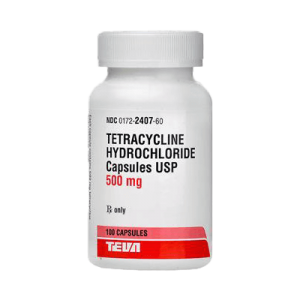In 1950 Professor Robert Woodward of Harvard University, working with a team of researchers from the pharmaceutical company Pfizer (KJ Brunings, Peter P. Regna, Francis A. Hochstein, Abraham Bavley, CR Stephens, LH Conover and Richard Pasternack), isolated the molecule from the Streptomyces rimosus strain and determined the chemical structure of the oxiteracycline, for which it also obtained the patent on the production process. The research process that led to this discovery lasted more than two years.
What Is Tetracycline?

Tetracyclines are antibiotics with a broad spectrum of action indicated for the treatment of many bacterial infections. Nowadays tetracyclines are used in the treatment of acne, in triple therapy for the eradication of Helicobacter pylori, and in the treatment of rosacea; historically speaking, it can be said that tetracyclines have been a very useful tool for the reduction of cholera deaths. Tetracyclines have been widely used both for the treatment of infectious diseases and abusively as feed additives for animals, with the aim of promoting their growth (the addition of antibiotics in the feed in order to exterminate the endogenous bacterial flora of the animals and increase them weight, can have serious consequences on consumers and is a strictly prohibited practice). This wide use has led to the appearance of bacterial strains resistant to tetracyclines, thus leading to a drastic reduction of their use in therapy.
Tetracyclines are a natural product of bacteria belonging to the Streptomyces family; Chlorotetracycline is produced from the Streptomyces aureofaciens strain, from which also derives its commercial name: Aureomycin (registered name).
Tetracyclines are considered the antibiotic of choice in rickettsial infections, mycoplasmas and chlamydia. In fact, tetracyclines are particularly effective in rickettsial infections including Rocky Mountain fever, relapsing epidemic typhus (Brill’s disease) and vesicular rickettiosis. Tetracyclines are also widely used for the treatment of sexually transmitted diseases (MST), because it appears that different forms of Clamydia are sensitive to this class of drugs. Tetracyclines have also proved effective in the treatment of acute and chronic infections with Brucella melitensis, B. suis and B. abortus. The association of a tetracycline, for example doxycycline, to another antibiotic, for example to an aminoglycoside antibiotic such as streptomycin, has given very convincing results in cases of acute brucellosis.
Tetracycline can be used to treat moderate to severe acne vulgaris, pneumonia caused by Mycoplasma penumoniae, Chlamydia psittaci (ornitos) or Chlamydia pneumoniae. Tetracycline also has a utility in urogenital infections caused by Chlamydia trachomatis. Another indication area is acute exacerbation of chronic bronchitis and acute sinusitis if patients are hypersensitive to penicillins or failing treatment.
Tetracycline in borrelia infections can also be used and should then be given to patients with erytema migrans if there is a detected penicillin allergy or evidence of dissemination such as neuroborreliosis.
Conditions Treated By Tetracycline
Tetracycline is an antibiotic that acts by inhibiting bacteria that cause infections. Tetracycline is used in various types of infections caused by bacteria that are sensitive to tetracycline. Can also be used in acne (pimples).
Conditions treated by tetracycline today are as follows: moderate to severe acne vulgaris. Pneumonia caused by Mycoplasma pneumoniae, Chlamydia psittaci (ornitos) or Chlamydia pneumoniae (TWAR). Acute exacerbation of chronic bronchitis. Urogenital infections caused by Chlamydia trachomatis. Borrelia infections: Erythema migrans in penicillin allergy or signs of dissemination such as neuroborreliosis. In case of acute sinusitis, Tetracycline should be reserved for patients who are hypersensitive to penicillins or failing treatment.
Not As Safe As Claimed?
All tetracyclines share the tetracyclic structure and all are amphoteric. The tetracyclines are compounds predisposed to give crystalline salts both with acids and with strong bases (this is due precisely to their amphoteric character); the tetracyclines have a complicated chromophore system that gives rise to absorption spectra characteristic of this class of antibiotics, which extend to the visible giving it its characteristic yellow color. All tetracyclines are able to chelate metal ions giving rise to chelates, which are insoluble in water and appear to have an appreciable role in the mechanism of action of these antibiotics. Due to their amphoteric character, tetracyclines are poorly soluble in water, while their hydrochlorides have considerable water solubility.
Another important feature of tetracyclines is to darken to light and to degrade in the presence of moisture and in an acidic environment to form anhydroderivatives, which are devoid of antibiotic power and more toxic than the starting antibiotics, this is probably due to the ability to interact with cell membranes in an aspecific way.
Tetracycline can cause various types of side effects, although not all people experience them. This is due to the different sensitivity that each individual has towards the drug. Therefore, it is not certain that the undesirable effects occur all and with the same intensity in each patient.
5 Situations When Tetracycline Is Not Appropriate
- Children under the age of eight should not use tetracycline because the active substance may be absorbed by the growing skeleton and discolour the tooth enamel.
- When taking the medicine there is a risk of skin reactions if exposed to strong sunlight. Therefore, avoid taking the drug during the days when you actively engage in sunbathing, even in the solarium. Occasionally, your doctor will prescribe that you stop during treatment during the summer.
- The drug affects the fetus, inter alia by storing it within the growing skeleton. Therefore, the medicine should not be used during the last half of pregnancy unless it is absolutely necessary. You can use the medicine when you are breastfeeding even though the active substance passes into the mother’s milk. It is unlikely that your child will be affected if you follow the dosing instructions.
- Hypersensitivity to the active substance or to any of the excipients listed under Contents in the package insert is also an example of an instance when the use of tetracycline is not appropriate.
- And lastly, do not take tetracycline if you suffer from esophagus stricture and / or obstructive change in the digestive tract.

